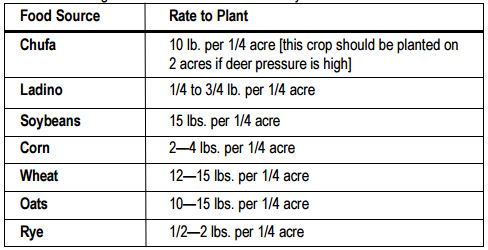Food Plots for Turkey
Food plots for turkey are a good idea, especially if you are interested in attracting birds to your property, providing supplemental nutrition for adult and growing birds, and use plots as part of an overall habitat management plan. Before implementing any turkey or wildlife management practice it is important to determine the advantages and disadvantages of the practice to see if it fits into your overall plan. One of the advantages of turkey food plots is that they can concentrate animals for viewing and/or hunting. White-tailed deer and turkey often respond rapidly to a new food plot.
Importantly, food plots can provide a critical source of late winter food and cover in times of poor production of native food sources. The soil disturbance resulting from food plot establishment is often of greater value to wildlife than even the grain production. This is due to native plant regrowth, which often favors forbs. In fact, high quality natural food plots can be created by simply strip disking areas and promoting early succession, high quality forbs and grasses to grow.
Native Food Plots for Turkey
Source: During a typical spring day before bugs become abundant, wild turkeys will make their way to a pasture or clearcut where they’ll feed on clover buds, dandelion leaves, and seeds such as those of gramagrass and panicums. Eventually any hens in the mix attract the attention of gobblers. Granted, it’s often tough for a hunter stationed in cover on the edge of a field or opening to get a tom to come within range, but that’s a nice problem to have. The fact that gobblers are likely to come into that field looking for hens warrants the extra strategizing it takes to get set up for a shot.
The point is, if you want to attract and keep more turkeys on your property, maybe you need to lay them a better table. Consider planting native grasses and plants on the edges of food plots, uncultivated fields, pastures and in other openings that receive an adequate amount of sunlight. If some of your property has been in the Conservation Reserve Program (CRP) for a while, chances are good that the right stuff might already be growing there. If it’s a new clearcut that doesn’t have much of anything growing on it, you can intervene with the native grass plantings before wax myrtle, sweetgums, horseweeds, and the like take over.
Planning Your Turkey Food Plot
The first step, after deciding if and how a food plot for turkey fits into your overall management plan, is proper planning and design to most benefit wild turkey. Size, location and shape are important considerations. If food plots are a part of your turkey management plan, they should comprise no more than about 5-8 percent of your open land. Ideal turkey plot sizes are 1/4 to 5 acres for turkey. Smaller plots are better for strictly hunting whereas larger food plots for turkey provide supplemental nutrition for a population. It’s important to note that larger plots can lessen the impact of predators because they do not concentrate wildlife, turkey to such a small area.
Shape is another important plot consideration. Food plots should be long and a minimum of 60 feet wide and at least 2-3 times as long. Wildlife prefer rectangles over squares. In fact, wildlife, turkey included, prefer irregular shapes more than any other plot shape. This is because they provide more edge, which turkey crave. A variety of plantings can be used as food plots for turkey.

Each seed species has advantages and disadvantages. The species planted to your turkey food plots will depend on latitude, precipitation and soil types. It’s hard to go wrong with oats, clover or chufa. Managers should perform a soil test prior to plot establishment. A roost site or mature wooded area should be close by, since turkey like to have refuge nearby. In general, a food plot for wild turkey should be available for every 40-50 acres of mature woodland.